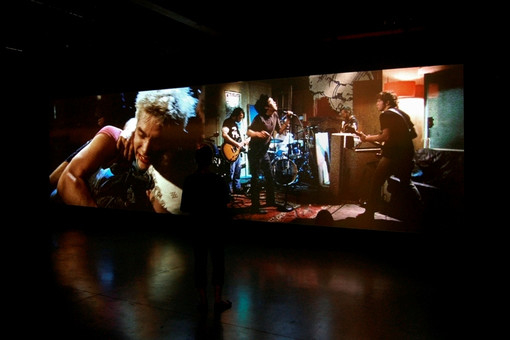In terms of context, many of Stokes’ works often closely relate to the musical history of the places for which he conceives an exhibition. In 2003, the artist initiated the ongoing project Real Arcadia, which looks back at 1980s and 90s British rave culture and in particular ‘cave raves’ which took place in caves in the English countryside. For the work Stokes established close contact with the original rave organisers and party-goers, collected, related TV reports and objects such as mix-tapes, records, photographs, posters, flyers and T-shirts, on the basis of which he not only archived the history of this culture, but also revived it. The film Long After Tonight (2005) engages with Northern Soul, a British music phenomena which emerged in northern England and Scotland at the end of the 1960s and had a decisive impact on people’s lifestyles, which continues to this day. During an artist’s residency in Austin, Texas, Matt Stokes created the work these are the days (2008) for Arthouse, in which he explored the punk, post-punk and DIY movements in Austin. Since the 1970s, these alternative music scenes have represented a kind of anti-attitude to the mainstream in Austin, developing into influential subcultures in the city. The film work The Gainsborough Packet (2008-09) emerged within the framework of a solo exhibition at the Baltic Centre for Contemporary Art in Gateshead and at the 176 in London. Reminiscent of the music video format and in the style of costume dramas and films, The Gainsborough Packet focuses on the move toward industrialisation in the mid 19th century and to the importance of music and song in the daily lives of the young urbanised population.
With his Kassel exhibition Matt Stokes devotes himself to the lasting effect of underground music as a counter-culture to the mainstream and its ability to spawn scenes which greatly influence people’s opinions and lifestyles, issues which run through Stokes' entire oeuvre. Against this background, he will combine the film The Gainsborough Packet with sculptural and object works emerging from the cultural context of rave music, and with a large film installation Cantata Profana which Stokes is producing specifically for his show in Kassel. Installed in a semicircle which will dominate the main wing of the Fridericianum and recall ancient amphitheatre architecture, this new film work will take a penetrating look at hardcore, grindcore and death metal music cultures that played an influential role in Kassel’s music scenes from the late 1980s to today. For this project, Stokes selected six extreme metal vocalists, one from Kassel and the others from the UK, USA, Norway and Netherlands. Using traditional composition techniques, Stokes combines their typical singing, which is usually devoid of lyrics. The auditive aspect, the singers’ movements and body postures, as well as the recording location that form the background for the film contributes to the special atmosphere of this unique choral work.
